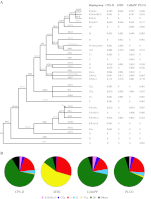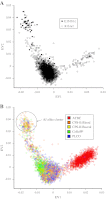Y chromosome haplogroups and prostate cancer in populations of European and Ashkenazi Jewish ancestry
- PMID: 22271044
- PMCID: PMC3374121
- DOI: 10.1007/s00439-012-1139-5
Y chromosome haplogroups and prostate cancer in populations of European and Ashkenazi Jewish ancestry
Abstract
Genetic variation on the Y chromosome has not been convincingly implicated in prostate cancer risk. To comprehensively analyze the role of inherited Y chromosome variation in prostate cancer risk in individuals of European ancestry, we genotyped 34 binary Y chromosome markers in 3,995 prostate cancer cases and 3,815 control subjects drawn from four studies. In this set, we identified nominally significant association between a rare haplogroup, E1b1b1c, and prostate cancer in stage I (P = 0.012, OR = 0.51; 95% confidence interval 0.30-0.87). Population substructure of E1b1b1c carriers suggested Ashkenazi Jewish ancestry, prompting a replication phase in individuals of both European and Ashkenazi Jewish ancestry. The association was not significant for prostate cancer overall in studies of either Ashkenazi Jewish (1,686 cases and 1,597 control subjects) or European (686 cases and 734 control subjects) ancestry (P(meta) = 0.078), but a meta-analysis of stage I and II studies revealed a nominally significant association with prostate cancer risk (P(meta) = 0.010, OR = 0.77; 95% confidence interval 0.62-0.94). Comparing haplogroup frequencies between studies, we noted strong similarities between those conducted in the US and France, in which the majority of men carried R1 haplogroups, resembling Northwestern European populations. On the other hand, Finns had a remarkably different haplogroup distribution with a preponderance of N1c and I1 haplogroups. In summary, our results suggest that inherited Y chromosome variation plays a limited role in prostate cancer etiology in European populations but warrant follow-up in additional large and well characterized studies of multiple ethnic backgrounds.
Figures


Similar articles
-
Contrasting patterns of Y chromosome variation in Ashkenazi Jewish and host non-Jewish European populations.Hum Genet. 2004 Mar;114(4):354-65. doi: 10.1007/s00439-003-1073-7. Epub 2004 Jan 22. Hum Genet. 2004. PMID: 14740294
-
Genetic architecture of prostate cancer in the Ashkenazi Jewish population.Br J Cancer. 2011 Sep 6;105(6):864-9. doi: 10.1038/bjc.2011.307. Epub 2011 Aug 9. Br J Cancer. 2011. PMID: 21829199 Free PMC article.
-
Extended Y chromosome haplotypes resolve multiple and unique lineages of the Jewish priesthood.Hum Genet. 2009 Nov;126(5):707-17. doi: 10.1007/s00439-009-0727-5. Epub 2009 Aug 8. Hum Genet. 2009. PMID: 19669163 Free PMC article.
-
Phylogeographic review of Y chromosome haplogroups in Europe.Int J Legal Med. 2021 Sep;135(5):1675-1684. doi: 10.1007/s00414-021-02644-6. Epub 2021 Jul 3. Int J Legal Med. 2021. PMID: 34216266 Review.
-
Heterogeneity of the Y chromosome in Afro-Brazilian populations.Hum Biol. 2004 Feb;76(1):77-86. doi: 10.1353/hub.2004.0014. Hum Biol. 2004. PMID: 15222681 Review.
Cited by
-
Human Chromosome Y and Haplogroups; introducing YDHS Database.Clin Transl Med. 2015 Dec;4(1):60. doi: 10.1186/s40169-015-0060-7. Epub 2015 Jun 10. Clin Transl Med. 2015. PMID: 26061870 Free PMC article.
-
Identification of specific Y chromosomes associated with increased prostate cancer risk.Prostate. 2014 Jun;74(9):991-8. doi: 10.1002/pros.22821. Epub 2014 May 6. Prostate. 2014. PMID: 24796687 Free PMC article.
-
Circum-Mediterranean influence in the Y-chromosome lineages associated with prostate cancer in Mexican men: A Converso heritage founder effect?PLoS One. 2024 Aug 16;19(8):e0308092. doi: 10.1371/journal.pone.0308092. eCollection 2024. PLoS One. 2024. PMID: 39150969 Free PMC article.
-
Contribution of MSMB promoter region gene polymorphism to early-onset prostate cancer risk in Mexican males.Oncotarget. 2019 Jan 22;10(7):738-748. doi: 10.18632/oncotarget.26592. eCollection 2019 Jan 22. Oncotarget. 2019. PMID: 30774776 Free PMC article.
-
Prostate cancer susceptibility and growth linked to Y chromosome genes.Front Biosci (Elite Ed). 2018 Mar 1;10(3):423-436. doi: 10.2741/e830. Front Biosci (Elite Ed). 2018. PMID: 29293466 Free PMC article. Review.
References
-
- Amundadottir LT, Thorvaldsson S, Gudbjartsson DF, Sulem P, Kristjansson K, Arnason S, Gulcher JR, Bjornsson J, Kong A, Thorsteinsdottir U, Stefansson K. Cancer as a complex phenotype: pattern of cancer distribution within and beyond the nuclear family. PLoS Med. 2004;1:e65. doi: 10.1371/journal.pmed.0010065. - DOI - PMC - PubMed
-
- Amundadottir LT, Sulem P, Gudmundsson J, Helgason A, Baker A, Agnarsson BA, Sigurdsson A, Benediktsdottir KR, Cazier JB, Sainz J, Jakobsdottir M, Kostic J, Magnusdottir DN, Ghosh S, Agnarsson K, Birgisdottir B, Le Roux L, Olafsdottir A, Blondal T, Andresdottir M, Gretarsdottir OS, Bergthorsson JT, Gudbjartsson D, Gylfason A, Thorleifsson G, Manolescu A, Kristjansson K, Geirsson G, Isaksson H, Douglas J, Johansson JE, Balter K, Wiklund F, Montie JE, Yu X, Suarez BK, Ober C, Cooney KA, Gronberg H, Catalona WJ, Einarsson GV, Barkardottir RB, Gulcher JR, Kong A, Thorsteinsdottir U, Stefansson K. A common variant associated with prostate cancer in European and African populations. Nat Genet. 2006;38:652–658. doi: 10.1038/ng1808. - DOI - PubMed
-
- Balaresque P, Bowden GR, Adams SM, Leung HY, King TE, Rosser ZH, Goodwin J, Moisan JP, Richard C, Millward A, Demaine AG, Barbujani G, Previdere C, Wilson IJ, Tyler-Smith C, Jobling MA. A predominantly neolithic origin for European paternal lineages. PLoS Biol. 2010;8:e1000285. doi: 10.1371/journal.pbio.1000285. - DOI - PMC - PubMed
Publication types
MeSH terms
Grants and funding
LinkOut - more resources
Full Text Sources
Medical

